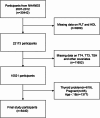The platelet to high-density lipoprotein cholesterol ratio is associated with thyroid hormone abnormalities based on NHANES 2007 to 2012 data
- PMID: 40596193
- PMCID: PMC12217886
- DOI: 10.1038/s41598-025-06187-3
The platelet to high-density lipoprotein cholesterol ratio is associated with thyroid hormone abnormalities based on NHANES 2007 to 2012 data
Abstract
Thyroid hormone abnormalities are closely associated with metabolic and cardiovascular diseases, yet easily accessible predictors remain limited. This study aimed to investigate the association between the platelet/high-density lipoprotein cholesterol ratio (PHR) and thyroid hormone levels, including thyroid dysfunction. Data from the National Health and Nutrition Examination Survey (NHANES) spanning 2007 to 2012 were analyzed. Weighted multiple linear and logistic regression models were used to assess the relationship between PHR and thyroid hormone levels, as well as the prevalence of thyroid dysfunction. Subgroup analyses, smoothing curve fitting, and threshold effect analyses were also conducted to further explore potential associations. A total of 8440 participants were included, with a mean age of 47.83 ± 18.48 years and a mean platelet/high-density lipoprotein cholesterol ratio (PHR) of 20.64 ± 8.43. Significant differences in thyroid hormone levels were observed across PHR quartiles, with higher PHR quartiles associated with elevated FT3, TT4, and hypothyroidism prevalence, and lower FT4/FT3 and FT4/TT4 ratios.In unadjusted models, PHR was positively correlated with FT3 (β = 0.007, P < 0.001), TT4 (β = 0.017, P < 0.001), and hypothyroidism (OR = 1.024, P = 0.012), and negatively correlated with FT4/FT3 and FT4/TT4 ratios. After adjusting for potential confounders, these associations remained significant. The odds of hypothyroidism were higher in Q2 and Q4 compared to Q1.Nonlinear associations were observed in the threshold effect analysis, with inflection points for FT3 and TT4 at 10.050 and 24.706, respectively. Below these points, PHR showed a negative association with FT3 and a positive association with TT4, while the associations plateaued above the inflection points. PHR, a readily available biomarker, is significantly associated with FT3, TT4, and the prevalence of hypothyroidism. These findings suggest that PHR could serve as a promising marker for predicting thyroid hormone abnormalities, especially in resource-limited settings where routine thyroid screening is not feasible.
Keywords: Cross-sectional study; Hypothyroidism; NHANES; Platelet/high-density lipoprotein cholesterol ratio; Thyroid hormones.
© 2025. The Author(s).
Conflict of interest statement
Declarations. Competing interests: The authors declare no competing interests. Ethical approval: All procedures conducted in studies involving human participants adhered to the ethical standards set by the institutional and/or national research committees, in line with the 1964 Helsinki Declaration and its subsequent amendments or equivalent ethical guidelines. The analyses were based on data from the National Health and Nutrition Examination Survey (NHANES). The study received approval from the Ethics Review Board of the National Center for Health Statistics. Detailed information is available on the NHANES website. Written informed consent was obtained from each participant prior to their inclusion in the NHANES database. Further details regarding the ethics application and informed consent process are also provided on the NHANES website. Consent for publication: All participants provided written informed consent before participating in the study, which included consent to publish anonymous quotes from individual participants. section.
Figures


Similar articles
-
Associations between thyroid function, thyroid hormone sensitivity indices, and frailty: Insights from a large cross-sectional study.Exp Gerontol. 2025 Sep;208:112822. doi: 10.1016/j.exger.2025.112822. Epub 2025 Jul 2. Exp Gerontol. 2025. PMID: 40614881
-
Platelet-to-high-density lipoprotein ratio as a biomarker for asthma risk in adolescents: insights from NHANES 2011-2023.Front Allergy. 2025 Jun 6;6:1593351. doi: 10.3389/falgy.2025.1593351. eCollection 2025. Front Allergy. 2025. PMID: 40546825 Free PMC article.
-
Association between thyroid function and thyroid homeostasis parameters and the prevalence and all-cause and cardiovascular mortality of chronic kidney disease: a population-based study.BMC Public Health. 2025 Aug 9;25(1):2715. doi: 10.1186/s12889-025-23695-z. BMC Public Health. 2025. PMID: 40783753 Free PMC article.
-
Relationship between Iron Deficiency and Thyroid Function: A Systematic Review and Meta-Analysis.Nutrients. 2023 Nov 15;15(22):4790. doi: 10.3390/nu15224790. Nutrients. 2023. PMID: 38004184 Free PMC article.
-
Association of Thyroid Function with Suicidal Behavior: A Systematic Review and Meta-Analysis.Medicina (Kaunas). 2021 Jul 15;57(7):714. doi: 10.3390/medicina57070714. Medicina (Kaunas). 2021. PMID: 34356995 Free PMC article.
References
-
- Cappola, A. R. & Ladenson, P. W. Hypothyroidism and atherosclerosis. J. Clin. Endocrinol. Metab.88, 2438–2444. 10.1210/jc.2003-030398 (2003). - PubMed
-
- Knudsen, N. et al. Small differences in thyroid function May be important for body mass index and the occurrence of obesity in the population. J. Clin. Endocrinol. Metab.90, 4019–4024. 10.1210/jc.2004-2225 (2005). - PubMed
-
- Louwerens, M. et al. Fatigue and fatigue-related symptoms in patients treated for different causes of hypothyroidism. Eur. J. Endocrinol.167, 809–815. 10.1530/EJE-12-0501 (2012). - PubMed
-
- Brouwer, J. P. et al. Thyroid and adrenal axis in major depression: a controlled study in outpatients. Eur. J. Endocrinol.152, 185–191. 10.1530/eje.1.01828 (2005). - PubMed
MeSH terms
Substances
Grants and funding
- Grant No. 2024JJ9251/Hunan Provincial Natural Science Foundation of China
- 2020NSFC-B007/Hunan Cancer Hospital Research Climbing Plan
- 2024ZK4141/Research Project of Science Popularization Special Project of Hunan Provincial Department of Science and Technology
- W20243236/Health Research Project of Hunan Provincial Health Commission
LinkOut - more resources
Full Text Sources
Medical

